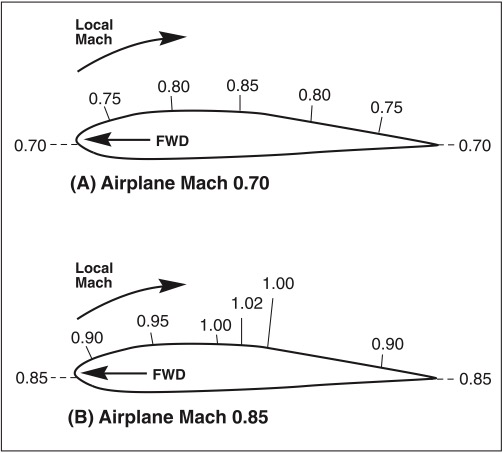As you progress through a career in aviation you will hopefully one day start flying high speed jet aircraft, a fun and challenging learning experience. However there are many differences when moving from low-speed flight to high-speed flight. Today we will briefly touch on some of the required knowledge associated with high speed flight beginning with mach numbers.
Mach number is the ratio of the true airspeed to the speed of sound (TAS ÷ Speed of Sound). For example, an aircraft cruising at Mach .80 is flying at 80% of the speed of sound. The speed of sound is Mach 1.0. When in high-speed flight we refer to our airspeed in mach rather than true airspeeds or indicated airspeeds. At any airspeeds above Mach 1 you would be breaking the sound barrier.
A large increase in drag occurs when the air flow around the aircraft exceeds the speed of sound (Mach 1.0). Because lift is generated by accelerating air across the upper surface of the wing, local air flow velocities will reach sonic speeds while the aircraft Mach number is still considerably below the speed of sound. With respect to Mach cruise control, flight speeds can be divided into three regimes—subsonic, transonic and supersonic. The subsonic regime can be considered to occur at aircraft Mach numbers where all the local air flow is less than the speed of sound. The transonic range is where some but not all the local air flow velocities are Mach 1.0 or above. In supersonic flight, all the air flow around the aircraft exceeds Mach 1.0. The exact Mach numbers will vary with each aircraft type but as a very rough rule of thumb the subsonic regime occurs below Mach .75, the transonic regime between Mach .75 and Mach 1.20, and the supersonic regime over Mach 1.20.
A limiting speed for a subsonic transport aircraft is its critical Mach number (MCRIT). That is the speed at which airflow over the wing first reaches, but does not exceed, the speed of sound. At MCRIT there may be sonic but no supersonic flow.
When an airplane exceeds its critical Mach number, a shock wave forms on the wing surface that can cause a phenomenon known as shock stall. If this shock stall occurs symmetrically at the wing roots, the loss of lift and loss of downwash on the tail will cause the aircraft to pitch down or “tuck under.” This tendency is further aggravated in sweptwing aircraft because the center of pressure moves aft as the wing roots shock stall. If the wing tips of a sweptwing airplane shock stall first, the wing’s center of pressure would move inward and forward causing a pitch up motion. See the Figure below.
The less airflow is accelerated across the wing, the higher the critical Mach number (i.e., the maximum flow velocity is closer to the aircraft’s Mach number). Two ways of increasing MCRIT in jet transport designs are to give the wing a lower camber and increase wing sweep. A thin airfoil section (lower camber) causes less airflow acceleration. The sweptwing design has the effect of creating a thin airfoil section by inducing a spanwise flow, thus increasing the effective chord length. See the Figure below.
Although a sweptwing design gives an airplane a higher critical Mach number (and therefore a higher maximum cruise speed), it results in some undesirable flight characteristics. One of these is a reduced maximum coefficient of lift. This requires that sweptwing airplanes extensively employ high lift devices, such as slats and slotted flaps, to get acceptably low takeoff and landing speeds. The purpose of high lift devices such as flaps, slats and slots is to increase lift at low airspeeds and to delay stall to a higher angle of attack.
Another disadvantage of the sweptwing design is the tendency, at low airspeeds, for the wing tips to stall first. This results in loss of aileron control early in the stall, and in very little aerodynamic buffet on the tail surfaces.







